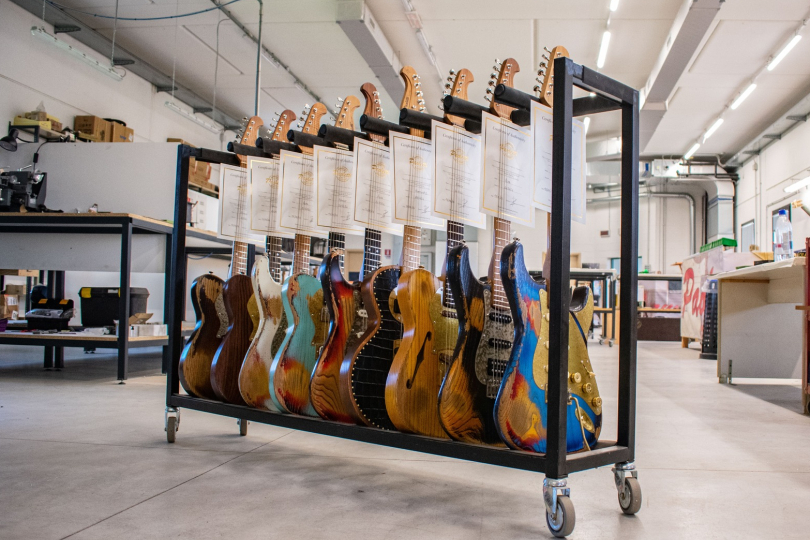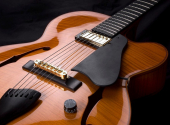
Legendary and Mythical Guitars #6: Paoletti Guitars
In our series, we've seen guitar companies born out of a love of music, the passion of technical geniuses and the love of skilled craftsmen for fine woodworking. Today we will talk about a guitar company that was founded on the tradition of making chianti, the red wine of Tuscany.
Australian discovery
Sometimes life plays tricks on you and maybe even makes fun of you. For example, one has to go to the exact opposite side of the globe to find out that not far from his home in Europe, in the region where he is about to go on a bike trip, there is a company that makes guitars – believe it or not – from wine barrels. Bizarre, isn't it?
Australia's capital, but not its largest city, Canberra, is home to a musical instrument shop – the largest in Australia, by contrast. A huge showcase store for an equally large online shop called Better Music boasts a guitar department the size of a supermarket. The business has been nominated by NAMM as one of the best musical instrument stores on the planet.
The impressive guitar section is managed by Matt, a good friend of mine, a great musician and a connoisseur of everything related to guitars, amps, effects and similar stuff. When I visited him at the shop, he showed me a few nice things: the Canadian Revv amps I started using thanks to him, or the Bartel tweed combos. And also a weird strat with peeled paint and brass plates instead of a plastic pick board. The headstock was signed by an unmistakably Italian name – Paoletti. The model I got to try had a neck like a table leg, but what was impossible to miss was the incredibly long sustain, even without the use of electricity. Matt spoke highly of the maker, so I did not doubt it would play well.
In vino veritas
When I wondered who this Mr Paoletti was, I found a story straight out of a marketing book. Are they kidding? Are those guitars really from 150-year-old wine barrels? Legend has it... you know. Anyway, they're made of chestnut, which is what wine barrels are usually made of.
Fabrizio Paoletti was born into a family that had been making chianti in Tuscany since the 19th century. That would be a nice story in itself if it was only about the wine. As a young man with an electrical engineering background, he received a guitar from his father and, as is often the case with technically minded individuals, what interested him most about it was how it was constructed, why it sounded the way it did, what had to be done to keep the neck and body together and so on. The idea of making a guitar out of a wine barrel was supposedly suggested to him by his friend, the great Italian guitarist Maurizio Solieri. Fabrizio gave it a try and the result was beyond expectation.
That's how it all started. It was 2005. Today, the company is known all over the world and these Italian delicacies are owned by many famous musicians. The marketing cliché once again: Tuscany, chianti, Leonardo da Vinci, Marco Polo, ancient barrels... A story like this just can't fail. But it would have a short life if the product wasn't at least very good, if not excellent. And in this case, it is.
Thanks to the customers' demand, the manufacturer quickly moved from the garage to a modern three-storey building, equipped with CNC machines and other necessary equipment to produce as many components as possible by himself. Yet all the promotional material stubbornly claims "Handmade in Italy". Anyway, anyone who knows a little about guitar making won't mind, because there are some operations where a machine will always be significantly more accurate and consistent than a human – even though "handmade" reads well. However, we can't accuse the Paoletti brand of pretending to be a craft product and mass-producing the instruments with machines. No way. Annual production is around five hundred units, and Fabrizio says that the volume will grow only very slowly in order to keep the quality of production in check.
Italian speciality: chestnut with roasted maple
What makes Paoletti guitars unique? Apart from the story of the wine barrels, it's the material itself. Chestnut as a wood for guitars has never been a big hit. It changes its physical properties over time, resonates in the mid and deep frequencies with little treble, and is definitely not one of the ideal materials for guitar making. But Fabrizio Paoletti was adamant in his choice, not only because of the family winery but also because of the excellent sustain. Due to the age and quality of the wood he uses, the risk of altering the resonant properties is relatively limited.
However, a lot of time was spent on researching what neck, fingerboard and hardware to add to the chestnut guitar to obtain the missing higher frequencies. Not to mention the lacquer! The luthier really made an effort to refine the components, and the first choice was roasted maple for the neck and fingerboard. What does it mean that it's roasted? It means that the wood is heated at high temperatures, which has several effects: it gets rid of moisture and becomes more stable, it hardens, it darkens and its grain becomes more pronounced. Its resonance properties are also said to improve.
Due to the limited production and the high degree of customisation, the factory is able to supply guitars with ebony, standard maple or exotic fretboards, but the necks made of roast maple are always there. The pickups are custom-made, as are the vintage fingerboards. As for the locking tremolos on some of the guitars, those come from Schaller. The tuners are usually Kluson Deluxe, the nut fret is made of bone (unless it's a locking one).
Considering the company's history, we can expect a more traditional, vintage design, where time and wood form the main visual sensations. So all finishes, whether natural or coloured, are treated in this same spirit. The manufacturer uses a specially developed nitro lacquer in a thin layer with good resonance properties so that it doesn't smother the great sustain of the chestnut body. Paoletti guitars are characterised by finishes that, thanks to Fender, are known as "heavy relic" – the guitar looks like it's from the 1960s and has been played for at least five hours every day. So the lacquer on the contact points is scuffed and the "base" or the wood itself shines through.
What do they have at Paoletti's?
The current model range is divided into four model series: the Wine, Loft, Lounge and Signature. The Wine line consists of models in natural finish and shapes of Strat, Telecaster, Jazzmaster and then something like SG and Explorer. The models differ from each other in pickup configuration and bridge type.
The Loft series is characterised by scuffed lacquer, and the body shapes mentioned above are complemented by something like The Paul with P-90 or humbuckers
In the Lounge line, we find both natural and "peeled" finishes, but there is one important element added, and that is the f-holes. That applies to Strats, Telecasters and Jazzmasters as well. Logically, we can also find the typical semi-acoustic models in the Gretsch style.
The Signature Series probably needs no explanation. Twenty-five models suggest that Paoletti guitars are now being played by quite a few prominent guitarists, not just in their native Italy, but all over the world. And because they are custom-made according to the guitarist's preferences, there is a bit of everything and no parameters are shared. The only criterion is "as the master wished".
In addition to guitars, Paoletti can also make you a bass. There are nine basic models to choose from, visually similar to classic Fenders with the same finishes as the guitars.
It is worth mentioning a limited edition called Marco Polo. It is a model created in honour of this year's 700th birthday of the famous Venetian traveller. Both in Venice and in Korcula, Croatia, they say he was born there, but the truth is that he was a citizen of the Republic of Venice. What's more, Croatia hasn't yet made a guitar in his honour. In the case of the Paoletti brand, this is an exclusive collector's piece with intricate inlays, visually reminiscent of period paintings and old maps. It has a piezo pickup in the bridge so that the electronics don't visually disturb this work of art.
Where and for how much?
If we look at the dealer map, we can immediately decipher where Paoletti's main guitar markets are. USA, Western Europe, Far East. That's to be expected. No one in Italy? Yes, we would look in vain for a dealership in Italy, as the company handles all its domestic business from its headquarters near Florence.
For example, you can buy their guitars in German dealership Zoundhouse in Dresden, or the famous Vienna music house Klangfarbe. If we take a peek at what's currently on sale there, we find basic models priced at around 4,000 Euros and then some of the luxurious upgrades for 8,000.
Who's on the list?
Which famous musicians have Paoletti guitars in their inventory? Probably the first major promoter of the brand was Richie Sambora of Bon Jovi, for whom the factory produced a signature model. Today, however, there are many famous names on the list. Dave Kilminster, a top instrumentalist who has accompanied Roger Waters and Steve Wilson, is a loyal supporter of the brand. He also has his own signature model with a rose graphic at Paoletti.
But other famous stars have also treated themselves to the Italian speciality. Slash, Kirk Hammett, Phil X, Richard Fortus, John Norum, Noel Gallagher, Rex Brown, James Hetfield, Johnny Depp and many others have a model in their collection.
To conclude
Italy is a country with no shortage of creative individuals in any field. Whether it is gastronomy, fashion, fine art or automotive design, Italians excel everywhere. I had a very good experience with Brunetti amplifiers, and since then I know that there are capable people in the field of musical instruments and music technology as well. A recent example is the Dexibell pianos. So now we can add Paoletti to the list of Italian terms we have learned through frequent use, such as barolo, primitivo, grappa, espresso, cappuccino, parmesan and so on. Maybe it will eventually become a generic term too, this time for unusual vintage guitars with long sustain.
If you have found an error or typo in the article, please let us know by e-mail info@insounder.org.





